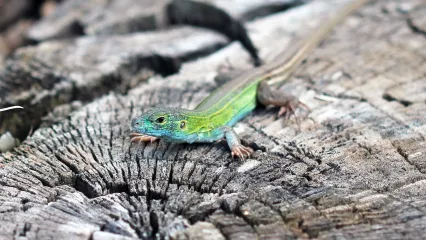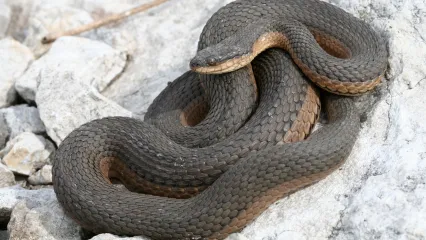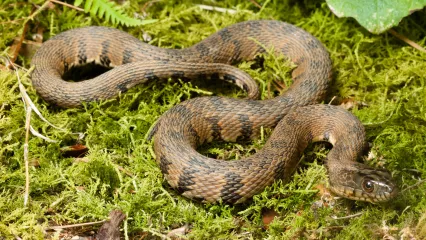
Description
The six-lined racerunner can be distinguished from all other lizards in the region by a combination of six narrow and well defined white or yellow stripes extending from the back of the head to about one-third of the tail, flat and rectangular scales arranged in eight rows on the belly and small granular non-overlapping scales. Background color of the body is dark brown to black, but this is covered by green, blue, or yellow in adult males, particularly in the head and thorax region. This coloration in males is particularly brilliant during the breeding season. Females have very little green or blue and juveniles have none on the body. Tails of juveniles are blue. Belly coloration is white to pink. Hindlimbs are much longer than forelimbs.
Size
Adult males reach a maximum snout to vent length of three and one-half inches whereas females are slightly smaller, reaching about three and three-eighths inches. The tail is twice the body length.
Habitat
Six-lined racerunners are most commonly associated with open habitats. In areas of forest, they can be found along roads and trails. In North America, the distribution of six-lined racerunners extends from western New Mexico, South Dakota, and Colorado east to Indiana and north-south from central Minnesota into Mexico.
Life Cycle
Six-lined racerunners are active from April through early October, but most activity occurs during May through August. During August, adults become very uncommon and most disappear by September. Most mating occurs during May and June and gravid females can be found from May through August. Clutch size varies from one to five and is associated with female size. Individual females can deposit two or more clutches each season. Hatchlings are about one and one-half inches in snout to vent length. These lizards reach sexual maturity at an age of one year. Six-lined racerunners feed on a variety of insects and other invertebrates, including grasshoppers and crickets, spiders, moths, caterpillars and insect pupae. They probably eat termites when they are available. While foraging, these lizards are very active, moving from place to place, tongue-flicking surfaces, and using their snouts and front legs to dig prey from the ground.
How To Observe
These are among the easiest lizards to find and observe. Look in open areas or along edges of unpaved roads. Daily activity during summer is concentrated from about 10 a.m. through 4 p.m. These lizards are extremely wary and alert, maintaining a good distance between themselves and an observer when approached. The first reaction of the lizard to your approach will be to run away, after which it will begin foraging, repeatedly looking back to see where you are. With binoculars and by keeping your distance, you can observe all normal behaviors of these active lizards. Within a few minutes, they will appear to forget you are there.
(This profile was created by Dr. Laurie Vitt as part of a partnership between the Wildlife Department and the Sam Noble Oklahoma Museum of Natural History. It was funded as part of a larger State Wildlife Grant to survey and inventory amphibians and reptiles of the Wildlife Management Areas of Oklahoma: T-35-P-1.)

